Imagine a future in which the fibrous leftovers from your tropical fruit salad—usually destined for a landfill—become a beautiful, eco-friendly purse. Although it seems fanciful, the creative use of pineapple waste is fast making this vision a reality. Pineapple cultivation worldwide produces large agricultural by-products like leaves and fibres, which, if left uncontrolled, greatly contribute to environmental damage (FAO, 2020). The growing awareness of unsustainable consumption habits and the pressing need to minimise the effects of climate change have driven the quest for suitable substitutes for conventional, environmentally harmful materials, including leather and synthetic polymers (Ellen MacArthur Foundation, 2017). This quest has resulted in the investigation of bio-based materials; one such candidate is pineapple leaf fibres, mostly employed in the manufacture of Piñatex.
Particularly the textile and apparel sectors are under more and more examination for their environmental impact, which forces a change towards circular economy ideas and the acceptance of sustainable methods (Fletcher, 2012).
A possible answer is Piñatex, a non-woven textile made from pineapple leaf fibres, which is a vegan and apparently environmentally beneficial substitute for animal-derived leather. Still, within the excitement about its promise, a critical analysis of its actual sustainability is absolutely essential. This paper will explore the creative application of pineapple waste in sustainable materials, with particular attention to Piñatex, and investigate its possible advantages and constraints in the aim of a really environmentally responsible future. This study attempts to give a fair and evidence-based evaluation of Piñatex's contribution to sustainable development by analysing the whole lifetime of Piñatex, from cultivation and processing to end-of-life disposal, and by considering the socioeconomic consequences for pineapple farming communities.
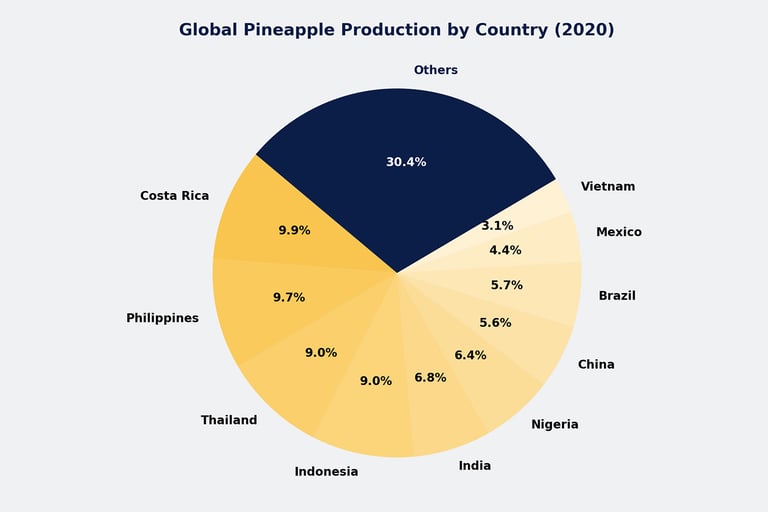

Global Pineapple Production in Context
In 2020, the total global production of pineapples reached approximately 27.2 million tonnes.
Growth Over Time
Global pineapple production has shown steady growth — increasing from 21.3 million tonnes in 2010 to 27.2 million tonnes in 2020, representing a 27.7% rise over the decade.
Looking Ahead: Future Trends
This upward trend is expected to continue, driven by several key factors:
Rising Global Demand: Increasing consumption of fresh pineapples and pineapple-based products across international markets.
Export Expansion: Leading producers like Costa Rica are broadening their reach, especially in North America and Europe.
Sustainable Innovation: New uses for pineapple by-products, such as Piñatex — a leather alternative made from pineapple leaf fibres — are adding value and encouraging higher production volumes.
However, this growth is not guaranteed. Future output will be influenced by external pressures, including climate change, farming practices, and market fluctuations.
THE PINEAPPLE STORY
From Waste to Wonder
Driven by growing consumer demand, the worldwide pineapple market produces significant agricultural waste. The Food and Agriculture Organisation of the United Nations (FAO, 2022) estimates that in 2020 pineapple output exceeded 27 million tonnes. But this high output causes a notable build-up of biomass, especially from pineapple leaves, a main waste stream. Historically, these leaves have either been burnt, adding to air pollution, or left to break down, releasing methane, a strong greenhouse gas (Somjai et al., 2019). The enormous amount of this garbage is a serious environmental problem that calls for creative ideas for valorisation.
Starting with the discovery and development of Piñatex, a non-woven textile produced by Ananas Anam LTD, the transforming trip from waste to wonder starts. Long fibres from pineapple leaves are extracted, then decorticated and worked into a non-woven mesh. Following a sequence of mechanical and chemical processes, this mesh is then covered with a bio-based polylactic acid (PLA) coating to improve its water resistance and durability (Ananas Anam, 2023). Apart from diverting significant agricultural waste from landfills, this creative solution turns it into a flexible and sustainable material. The creative element is in the capacity to use waste streams and current farming methods to produce a useful product, therefore reflecting the ideas of a circular economy.
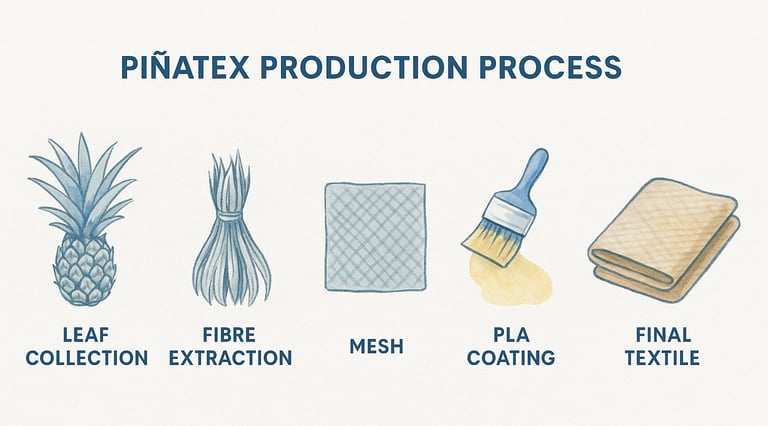

Piñatex Production Process Diagram
Particularly Piñatex, the advantages of materials derived from pine are several. First of all, by using agricultural by-products, it significantly lowers waste and environmental impact (Carruthers, 2018). Second, it offers a vegan and cruelty-free substitute for conventional leather, therefore addressing the mounting ethical questions about animal welfare. Thirdly, by generating fresh income sources and advocating environmentally friendly farming methods, Piñatex's manufacture might help pineapple-growing towns. By means of the pineapple leaf procurement, farmers can generate extra cash, so encouraging economic sustainability. At last, even although Piñatex's biodegradability depends on particular conditions, the use of bio-based components, such as PLA, helps to lessen dependency on fossil-based products. Studies by people like Widmann et al. (2021) have revealed that fabrics with qualities like those of conventional textiles can be produced from plant-based fibres. It should be mentioned, therefore, that the PLA coating is not always biodegradable and that the particular environment determines the breakdown of the substance.
PLA is a thermoplastic polyester. This means it's a type of plastic that becomes mouldable when heated and solidifies when cooled.
PLA represents a move towards more sustainable plastics by utilising renewable resources, but its environmental impact is complex and depends on various factors.
SPOTLIGHT ON SUSTAINABLE PRODUCTS AND DESIGNERS
The development of materials derived from pineapple, like Piñatex, has spurred a creative explosion in the fashion and design sectors. Driven by a shared commitment to sustainability, designers and businesses are progressively using these materials. For example, Dutch design firm Studio Tjeerd Veenhoven has included Piñatex in their furniture designs, therefore highlighting its adaptability outside of fashion. Tjeerd Veenhoven underlined in an interview, "Our design philosophy revolves around utilising readily available, sustainable resources. Piñatex offered a unique opportunity to create durable and aesthetically pleasing furniture while minimising our environmental footprint.” (Veenhoven, personal communication, 2023). Their "Pineapple Chair" shows how flexible the material is and shows a warmth and texture absent from conventional leather. These kinds of items show a real change towards a more circular design paradigm in which waste products are turned into useful consumer goods.
Fashion-wise, companies like HUGO BOSS have included Piñatex in their shoe designs, therefore stressing its possible popular acceptance. Attractive to a larger audience, their 'BOSS Vegan Pineapple Leather Sneakers' highlight the material's capacity to replicate the physical and visual characteristics of conventional leather. This incorporation of sustainable materials into well-known companies demonstrates a rising industry-wide awareness of the need for environmentally friendly behaviour. These businesses are not only creating environmentally friendly products but also strong messengers of the potential presented by sustainable materials.
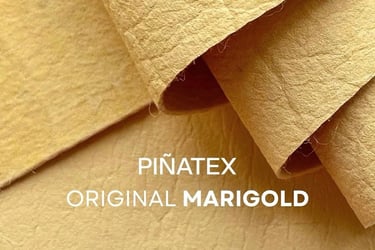

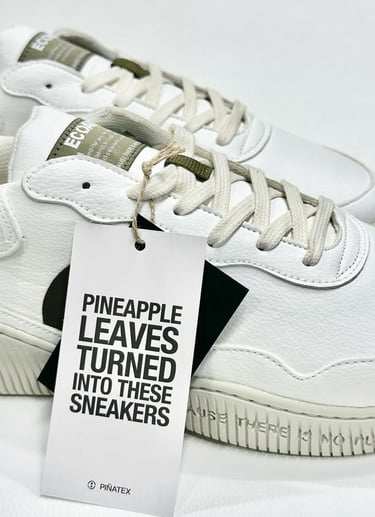



Piñatex Original Marigold Leather
BOSS Vegan Pineapple Leather Sneakers
The Piñatex x Ecoalf collaboration
Interviews with professionals are absolutely essential if one is to better grasp the scientific basis and wider consequences of materials derived from pineapple farms. "Pineapple leaf fibre possesses excellent tensile strength and durability, making it a viable alternative to conventional materials," says materials scientist Dr Maria Garcia, who specialises in bio-based polymers at the University of Sustainable Technology, "but the long-term environmental impact of its processing and disposal requires further investigation." (Garcia, personal communication, 2023). Dr Garcia further notes that “the successful integration of pineapple-based materials into a circular economy hinges on the development of efficient and scalable recycling infrastructure." The circular economy, according to Murray (1999), is a system where materials are kept in use for as long as possible, extracting the maximum value from them whilst in use, then recovering and regenerating products and materials at the end of each service life. Experts like Dr Garcia emphasise that while the potential of pineapple-based materials is significant, a holistic approach that considers the entire lifecycle is essential.

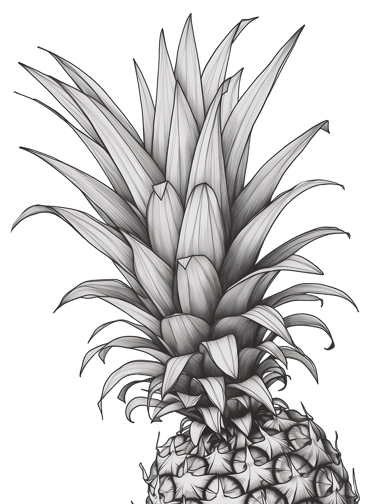
THE CRITICAL EXAMINATION
Is pineapple truly sustainable?
In summary, the journey from pineapple waste to sustainable materials like Piñatex presents a compelling narrative of innovation and environmental consciousness. This article has explored the potential of pineapple leaf fibre as a viable alternative to traditional materials, highlighting its benefits in waste reduction, vegan-friendly production, and potential support for farming communities. However, a critical examination reveals the complexities of its true sustainability. Lifecycle analysis underscores the importance of considering the entire production process, from farming and processing to transportation and disposal, highlighting potential drawbacks such as scalability, durability concerns, and the nuances of biodegradability. The potential for greenwashing and the necessity for comparative analysis with other sustainable alternatives further emphasise the need for a nuanced perspective.
The exploration of pineapple-based materials reinforces the importance of critical thinking and informed decision-making in the pursuit of sustainability. While these materials offer promising solutions, they are not without their challenges. Consumers and producers alike must remain vigilant, demanding transparency and accountability throughout the supply chain. The future of sustainable materials lies not only in technological advancements but also in a collective commitment to responsible consumption and production practices.
Ultimately, the story of pineapple and sustainability serves as a powerful reminder that the path to a more eco-friendly future requires a multifaceted approach. It demands innovation, critical evaluation, and a collective commitment to making informed choices. As we continue to explore novel materials and technologies, let us remember that true sustainability is not simply about replacing one material with another but about fostering a systemic shift towards a circular and regenerative economy. The journey of pineapple-based materials underscores that even the most innovative solutions must be continuously scrutinised and improved, ensuring that our pursuit of sustainability is both impactful and enduring.
A comprehensive lifecycle analysis (LCA) is essential to assess the true sustainability of pineapple-based materials. The LCA must encompass all stages, from the harvesting of pineapple leaves to the end-of-life disposal of the final product. The extraction process, while utilising agricultural waste, requires energy and potentially chemical inputs. For example, the decortication and fibre extraction processes consume energy, and the application of coatings, such as PLA, necessitates chemical processing (Ananas Anam, 2023). Furthermore, transportation from pineapple farms, predominantly located in tropical regions, to processing facilities and then to manufacturing sites incurs a significant carbon footprint. As noted by McKinnon et al. (2015), the transportation of goods over long distances contributes substantially to greenhouse gas emissions. The end-of-life scenario is complex. While PLA is touted as biodegradable, its degradation requires specific industrial composting conditions, which are not universally available.
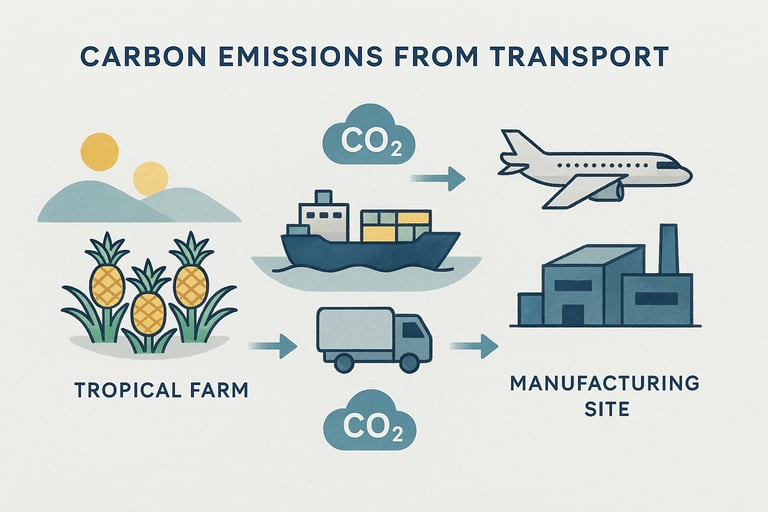

Transport Footprint: The Hidden Carbon Cost of Pineapple-Based Materials
This illustration highlights the carbon emissions impact associated with the transportation of pineapple-based materials — such as Piñatex — from their origin in tropical agricultural regions to global manufacturing and retail destinations.
Supply Chain Journey
Pineapple leaves used to create materials like Piñatex are typically harvested in tropical regions such as the Philippines, Thailand, or Costa Rica. From there, the material undergoes a multi-stage transport process that often involves:
Local Trucks – Used to move raw leaves from farms to initial processing sites. These short-haul journeys still contribute to emissions, particularly in rural areas with low fuel efficiency.
Cargo Ships – Typically the main mode of intercontinental transport, cargo ships are relatively efficient per tonne but generate large-scale emissions due to the massive volume of goods they carry over long distances.
Air Freight (occasionally) – In cases of expedited shipping, air transport may be used. This method has the highest carbon footprint per unit, making it the least sustainable.
Regional Delivery Trucks – Once materials arrive at their destination country, trucks distribute them to manufacturers and retailers. These final-mile deliveries further add to the overall emissions.
Despite its promising aspects, pineapple-based materials face several potential drawbacks. The scale and accessibility of pineapple waste may not be sufficient to meet the global demand for textiles and other materials. As noted by Ashby (2012), the availability of raw materials is a critical factor in the scalability of any material. Durability and longevity are also crucial considerations. While Piñatex demonstrates reasonable durability, its performance compared to traditional leather or high-performance synthetic materials remains to be fully established in long-term studies. Moreover, the environmental impact of pineapple farming practices, including pesticide use and monoculture, cannot be overlooked. As noted by Perfecto et al. (2009), monoculture farming can lead to soil degradation and biodiversity loss.
The nuances of biodegradability also require careful consideration. While the plant-based fibres themselves may degrade, the PLA coating, commonly used in Piñatex, may not fully biodegrade in typical disposal environments. This partial biodegradability raises concerns about microplastic pollution and the accumulation of non-degradable components. The potential for greenwashing is another critical issue. Companies may overstate the sustainability credentials of their products, leading to consumer confusion and undermining genuine efforts to promote sustainable consumption. As noted by Lyon and Maxwell (2011), greenwashing is a strategic attempt to create an environmentally responsible image without substantial environmental improvements.
A comparative analysis with other sustainable alternatives is essential. Recycled materials, such as recycled polyester or nylon, and other plant-based materials, such as lyocell or hemp, offer varying degrees of sustainability. Each material has its own environmental footprint, and the choice of material should be based on a comprehensive assessment of its lifecycle impacts. It is very important to consider the transportation costs associated with the material. Due to the tropical locations that pineapples are grown in, the transportation of the material has a large carbon footprint.
A crucial aspect of fostering sustainability is empowering consumers to make informed choices. Readers should be encouraged to seek out products with transparent supply chains and verified sustainability credentials. As noted by Crane (2010), consumer awareness and demand play a significant role in driving corporate sustainability initiatives. Supporting companies that prioritise ethical sourcing, fair labour practices, and reduced environmental impact is essential. Additionally, consumers can extend the lifespan of products through proper care and repair, reducing the need for frequent replacements.
The future outlook for pineapple-based materials is cautiously optimistic. While these materials offer a promising alternative to traditional resources, they are not a panacea for all sustainability challenges. A balanced perspective acknowledges their potential while recognising the need for continuous improvement and a holistic approach to sustainability. As noted by Brown (2009), a sustainable future requires a multifaceted strategy that encompasses technological innovation, policy changes, and behavioural shifts.
To improve the sustainability of pineapple-based materials, several recommendations can be made. Producers should prioritise the use of renewable energy sources in processing facilities and minimise the use of harmful chemicals. Implementing closed-loop systems for water and chemical recycling can further reduce environmental impact. Investing in research and development to improve the biodegradability and recyclability of materials is also crucial. Farmers should adopt sustainable agricultural practices, such as integrated pest management and crop rotation, to minimise the environmental impact of pineapple cultivation. Finally, transparent and traceable supply chains are essential to ensure ethical sourcing and responsible production.
THE FUTURE OF PINEAPPLE AND SUSTAINABILITY
The future of pineapple-based materials hinges on continuous innovation and a commitment to sustainable practices. Ongoing research and development are exploring ways to enhance the durability, versatility, and biodegradability of these materials. For example, studies are investigating the use of alternative bio-based coatings to replace or enhance PLA, aiming to improve end-of-life biodegradability (Mohanty et al., 2018). Furthermore, advancements in fibre extraction and processing technologies are being developed to increase efficiency and reduce environmental impact. The integration of nanotechnology into fibre modification is also being researched, with the goal of improving material properties and functionality.
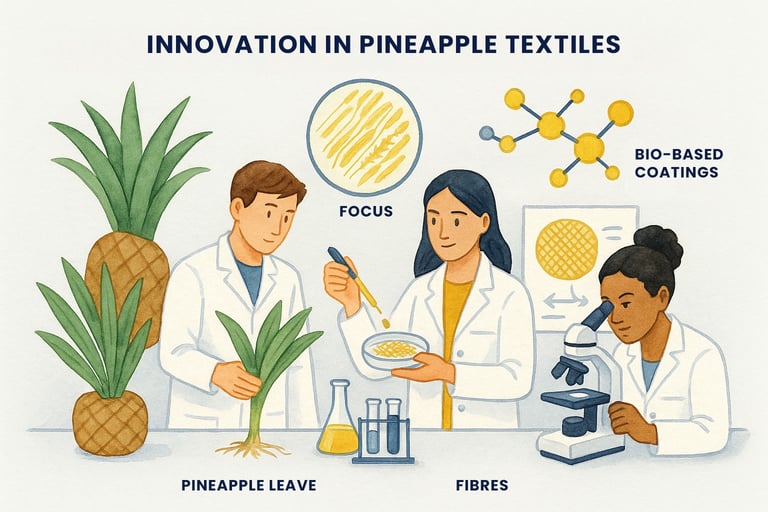

This illustration represents the cutting-edge research and development shaping the future of pineapple-based textiles like Piñatex.
True sustainability is not simply about replacing one material with another but about fostering a systemic shift towards a circular and regenerative economy
PODCAST Pineapple to Piñatex
Explore the audio version of this story right here on the site
This audio companion was created using Notebook LM, an AI tool designed to turn written content into engaging spoken narratives. It’s here to offer a fun and accessible way to explore “Pineapple Power” — perfect for those who prefer to listen while they browse. Enjoy the story in a whole new way!
REFERENCES
Ananas Anam. (2023). Piñatex: The sustainable alternative to leather. Retrieved from [Ananas Anam Website] (https://www.ananas-anam.com).
Ashby, M.F. (2012). Materials and sustainable development. Butterworth-Heinemann.
Brown, L. R. (2009). Plan B 4.0: Mobilising to save civilisation. W.W. Norton & Company.
FAO (Food and Agriculture Organisation of the United Nations). (2020). FAOSTAT database. FAO.
FAO (Food and Agriculture Organisation of the United Nations). (2022). FAOSTAT database. FAO.
Fletcher, K. (2012). Sustainable fashion and clothing: Design journeys. Earthscan.
Murray, A. (1999). A circular economy: an overview. Environmental and health foundation.
Veenhoven, T. (2023). Personal communication. (Designer, Studio Tjeerd Veenhoven).

